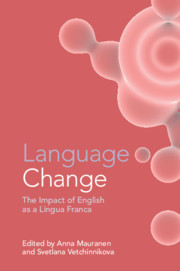Book contents
- Language Change
- Language Change
- Copyright page
- Contents
- Figures
- Tables
- Contributors
- Acknowledgements
- Abbreviations
- Introduction
- Part I Pooling Perspectives
- Part II Zooming in on ELF
- 7 ELF, Language Change, and Social Networks
- 8 ELF and Language Change at the Individual Level
- 9 Are Multilinguals the Better Academic ELF Users?
- 10 The Role of Co-Textual and Contextual Cues for Intelligibility in ELF Interactions
- 11 Exploring the Pragmatics of Computer-Mediated English as a Lingua Franca Communication
- 12 Development of Shared Multilingual Resources in ELF Dyadic Interaction
- 13 The Role of Translanguaging in ELF Advice Sessions for Asylum Seekers
- Index
- References
13 - The Role of Translanguaging in ELF Advice Sessions for Asylum Seekers
from Part II - Zooming in on ELF
Published online by Cambridge University Press: 17 December 2020
- Language Change
- Language Change
- Copyright page
- Contents
- Figures
- Tables
- Contributors
- Acknowledgements
- Abbreviations
- Introduction
- Part I Pooling Perspectives
- Part II Zooming in on ELF
- 7 ELF, Language Change, and Social Networks
- 8 ELF and Language Change at the Individual Level
- 9 Are Multilinguals the Better Academic ELF Users?
- 10 The Role of Co-Textual and Contextual Cues for Intelligibility in ELF Interactions
- 11 Exploring the Pragmatics of Computer-Mediated English as a Lingua Franca Communication
- 12 Development of Shared Multilingual Resources in ELF Dyadic Interaction
- 13 The Role of Translanguaging in ELF Advice Sessions for Asylum Seekers
- Index
- References
Summary
This chapter explores the role of translanguaging in ELF advice practices at a UK charity supporting refugees and asylum seekers. Previous research has highlighted how multilingualism is an essential aspect of ELF (Jenkins 2015), and the role of multilingual resources has received increased attention in the latest conceptualizations and linguistic analysis. However, the contribution and nature of multilingualism in relation to ELF need to be investigated further. This study addresses the role of translanguaging in high-stakes ELF environments, such as advice sessions for refugees and asylum seekers.In this chapter, I first explore the notion of translanguaging and then explain the linguistic ethnographic approach taken to collect and analyse the data. The qualitative analysis of the data shows the complexity of advice practices in relation to the use of multilingual resources in ELF, and demonstrates how translanguaging can be used for at least three functions: pedagogical, explanatory and interpersonal.
Keywords
- Type
- Chapter
- Information
- Language ChangeThe Impact of English as a Lingua Franca, pp. 336 - 355Publisher: Cambridge University PressPrint publication year: 2020
References
- 1
- Cited by

